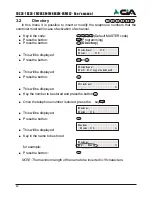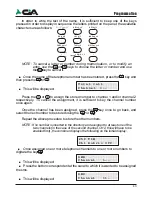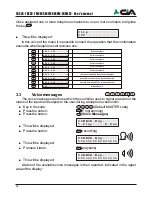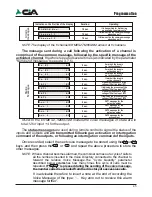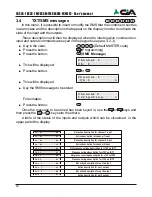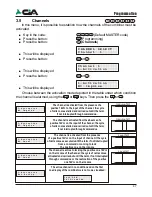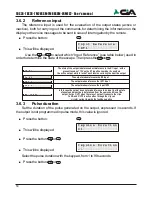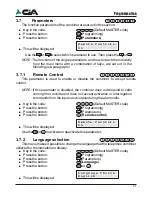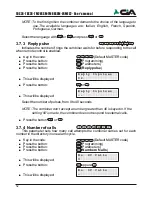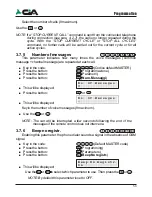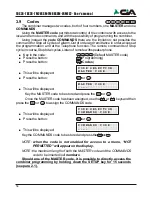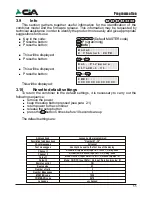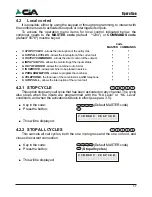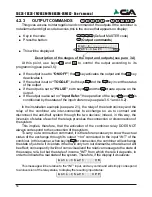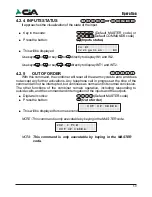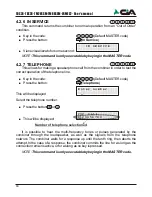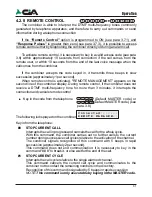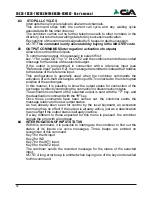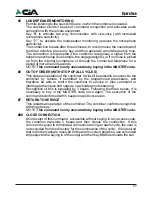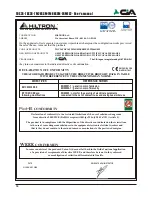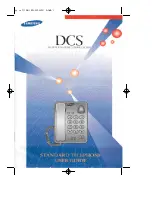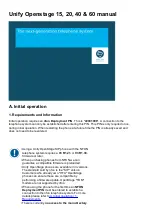
57
Operation
56
TDC26-TDC36-TM26GSM-TM66GSM-ERMES2- User’s manual
4.2
Local control
It is possible, either by using the keypad or through programming, to interact with
the combiner so as to activate its outputs or interrogate its inputs.
To access the operation menu items for local control indicated below, the
combiner needs to the
MASTER code
(default “1234”) or
COMMANDS code
(default "5678") must be keyed.
Code
MASTER COMMANDS
!
1 - STOP CYCLES
-
allows the interruption of the call cycles
•
•
!
2 - STOP ALL CYCLES
- allows the interruption of the current call
•
/
!
3 - OUTPUT COMMANDS
- allows the direct control of the outputs
•
•
!
4 - INPUT STATUS
- allows the monitoring of the inputs status
•
•
!
6 - OUT OF ORDER
- allows the combiner out of order
•
/
!
7 - IN SERVICE
- allows combiner to be placed in service
•
/
!
8 - PROGRAMMATION
- allows to program the combiner
•
/
!
9 -
TELEPHONE
- the local use of the combiner as a GSM telephone
•
/
!
0
- STOP CALL
- allows the interruption of the current call
•
•
4.2.1 STOP
CYCLE
This option stops any call cycle that has been activated on any channel. The cycle
also stops when the inputs are programmed with the “NA Level” or “NC Level”
conditions, and when the activation status is in effect (see para 3.5).
!
Key in the code:
(Default MASTER code)
!
Press the button:
!
This will be displayed:
4.2.2 STOP
ALL
CYCLES
This cancels all call cycles, both the one in progress and the one on hold, and
closes the current connection.
!
Key in the code:
(Default MASTER code)
!
Press the button:
(
Stop all cycles
)
!
This will be displayed:
C O M M A N D
P E R F O R M .
C O M M A N D
P E R F O R M .
4
Operation
Use of combiner is made easier by the presence of the display which provides
information on the activities and status of the combiner. The backlight of the display is
automatically controlled: this activates when the user presses any key or when a
channel is activated, and it turns off 20 seconds following the end of any operation.
The information is displayed on two lines; the first displays those relative to the
operations of the combiner on the telephone line, while the information on the second
relates to the status of the two channels.
First line of the display:
!
Init GSM....
Initialization of the module of telephone logon GSM
!
INSERT SIM
The combiner attends the insertion of one SIM card
!
REGISTRATION..
Attempt of recording on the telephone net in course
!
20¥ TIM
It indicates the happened logon with the specified
telephone manager and marks it in particular the
intensity of marks them (from 1 to 30) with the symbol
¥ blinking
!
20¥ Call..
In course an attempt of telephone call
!
20¥ Failed Call
The call attempt has not had answer
!
20¥ Occupied
The called number turns out occupied or the call has
been refused
!
20¥ Ship SMS
Shipment of the SMS in course
!
20¥ And of call
The telephone call is concluded
!
20¥ Connected
Connection out telephone logon
!
Called rec.
Called reception telephone
Second line of the display:
!
Chn Rubric off
No telephone number is associated to the channel
!
Chn Disabled
The channel n is Not Active.
!
Chn
On the input programmed Input INT the tension of
12V is not present
!
Chn In Attesa
The channel is ready and in attended of it marks them
of activation
!
Chn Interval
Pause between one telephone call and the next.
!
Chn Timer 0012
Counter of the time remaining between the activation
of the channel and the departure of the cycle of calls
!
Remote Control
Activation of the control from remote during the
connection
The activation of a channel generates a sequence of calls towards the telephone
numbers inserted in the Directory, sending the recorded voice message (common
m channel message),which is repeated the number of times established by
the “Number of messages” parameter. The complete cycle of calls is repeated for a
number of times determined by the "Number of calls” parameter.
Interdict
4.1
General description of operation

